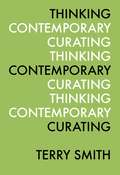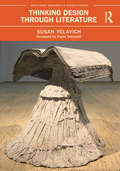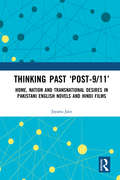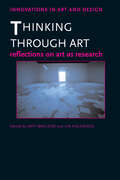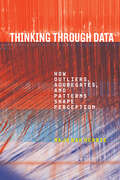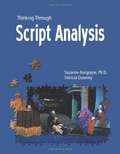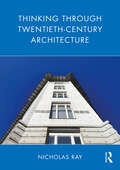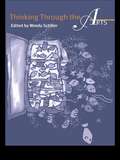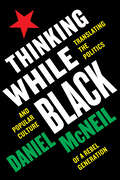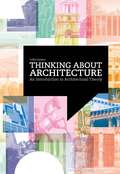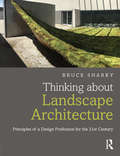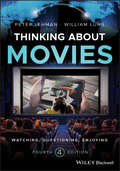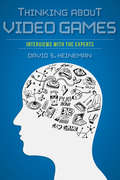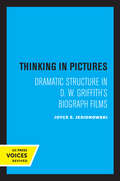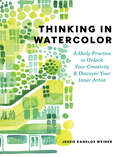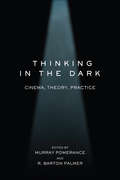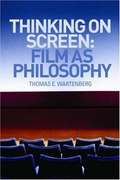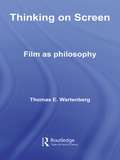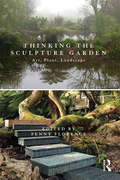- Table View
- List View
Thinking Contemporary Curating
by Terry Smith Kate FowleWhat is contemporary curatorial thought? Current discourse on the topic is heating up with a new cocktail of bold ideas and ethical imperatives. these include: cooperative curating, especially with artists; the reimagination of museums; curating as knowledge production; the historicization of exhibitionmaking; and commitment to extra-artworld participatory activism. Less obvious, but increasingly of concern, are issues such as rethinking spectatorship, engaging viewers as co-curators and the challenge of curating contemporaneity itself. In these five essays, art historian and theorist Terry Smith surveys the international landscape of current thinking by curators; explores a number of exhibitions that show contemporaneity in recent, present and past art; describes the enormous growth world wide of exhibition infrastructure and the instability that haunts it; re-examines the contribution of artist-curators and questions the rise of curators utilizing artistic strategies; and, finally, assesses a number of key tendencies in curating as responses to contemporary conditions. Thinking Contemporary Curating is the first book to comprehensively chart the variety of practices of curating undertaken today, and to think through, systematically, what is distinctive about contemporary curatorial thought.This is the eBook edition of Thinking Contemporary Curating, print form to be published in September 2012.
Thinking Design Through Literature (Routledge Research in Design Studies)
by Susan YelavichThis book deploys literature to explore the social lives of objects and places. The first book of its kind, it embraces things as diverse as escalators, coins, skyscrapers, pottery, radios, and robots, and encompasses places as various as home, country, cities, streets, and parks. Here, fiction, poetry, and literary non-fiction are mined for stories of design, which are paired with images of contemporary architecture and design. Through the work of authors such as César Aires, Nicholson Baker, Lydia Davis, Orhan Pamuk, and Virginia Woolf, this book shows the enormous influence that places and things exert in the world.
Thinking Out of Sight: Writings on the Arts of the Visible (The\france Chicago Collection)
by Jacques DerridaJacques Derrida remains a leading voice of philosophy, his works still resonating today—and for more than three decades, one of the main sites of Derridean deconstruction has been the arts. Collecting nineteen texts spanning from 1979 to 2004, Thinking out of Sight brings to light Derrida’s most inventive ideas about the making of visual artworks. The book is divided into three sections. The first demonstrates Derrida’s preoccupation with visibility, image, and space. The second contains interviews and collaborations with artists on topics ranging from the politics of color to the components of painting. Finally, the book delves into Derrida’s writings on photography, video, cinema, and theater, ending with a text published just before his death about his complex relationship to his own image. With many texts appearing for the first time in English, Thinking out of Sight helps us better understand the critique of representation and visibility throughout Derrida’s work, and, most importantly, to assess the significance of his insights about art and its commentary.
Thinking Past ‘Post-9/11’: Home, Nation and Transnational Desires in Pakistani English Novels and Hindi Films
by Jayana JainThis book offers new ways of constellating the literary and cinematic delineations of Indian and Pakistani Muslim diasporic and migrant trajectories narrated in the two decades after the 9/11 attacks. Focusing on four Pakistani English novels and four Indian Hindi films, it examines the aesthetic complexities of staging the historical nexus of global conflicts and unravels the multiple layers of discourses underlying the notions of diaspora, citizenship, nation and home. It scrutinises the “flirtatious” nature of transnational desires and their role in building glocal safety valves for inclusion and archiving a planetary vision of trauma. It also provides a fresh perspective on the role of Pakistani English novels and mainstream Hindi films in tracing the multiple origins and shifts in national xenophobic practices, and negotiating multiple modalities of political and cultural belonging. It discusses various books and films including The Reluctant Fundamentalist, Burnt Shadows, My Name is Khan, New York, Exit West, Home Fire, AirLift and Tiger Zinda Hai. In light of the twentieth anniversary of 9/11 attacks, current debates on terror, war, paranoid national imaginaries and the suspicion towards migratory movements of refugees, this book makes a significant contribution to the interdisciplinary debates on border controls and human precarity. A crucial work in transnational and diaspora criticism, it will be of great interest to researchers of literature and culture studies, media studies, politics, film studies, and South Asian studies.
Thinking Through Analogies: Grades 3-6
by Bonnie L. RisbyAn analogy is a comparison between two things. It points out the similarities between two things that might be different in all other respects. Analogies cause us to think analytically about forms, uses, structures, and relationships. This all-time favorite resource not only gives students a chance to practice solving analogies, but also invites them to open their minds to a completely new way of analyzing the elements of analogies. Each page introduces several categories of analogies. Each category expands students' way of viewing the world and contrasting and comparing elements. Thinking Through Analogies also instills the tools whereby students can create relationships to enhance their creative and formal writing, as well as to heighten their critical thinking in test taking. Other books that teach analogies are Analogies for Beginners and Analogies for the 21st Century.Grades 3-6
Thinking Through Art: Reflections on Art as Research (Innovations In Art And Design Ser.)
by Katy Macleod Lin HoldridgeFocusing on a unique arena, Thinking Through Art takes an innovative look at artists’ experiences of undertaking doctorates and asks: If the making of art is not simply the formulation of an object but is also the formation of complex ideas then what effect does academic enquiry have on art practice? Using twenty-eight pictures, never before seen outside the artists’ universities, Thinking Through Art focuses on art produced in higher educational environments and considers how the material product comes about through a process of conceiving and giving form to abstract thought. It further examines how this form, which is research art sits uneasily within academic circles, and yet is uniquely situated outside the gallery system. The journal articles, from eminent scholars, artists, philosophers, art historians and cultural theorists, demonstrate the complexity of interpreting art as research, and provide students and scholars with an invaluable resource for their art and cultural studies courses.
Thinking Through Data: How Outliers, Aggregates, and Patterns Shape Perception (Sensing Media: Aesthetics, Philosophy, and Cultures of Media)
by Maja Bak HerrieWe encounter digital data processing on a range of platforms and in a multitude of contexts today: in the predictive algorithms of the financial sector, in drones, insurance, and risk management, in smart cities, biometrics, medicine, and more. This fascinating book explores the historical context of the current data-driven paradigm and explains how elusive yet crucial statistical concepts such as outliers, aggregates, and patterns form how we sense and make sense of data. From the sixteenth century's embodied measurements of the foot, through the blurred facial features of L'Homme Moyen, to the image aggregates of today's security systems, the examples collected in this book illustrate the central role of aesthetics throughout the history of statistical knowledge production. Taking its point of departure in analyses and discussions of contemporary artistic experiments by Rossella Biscotti, Stéphanie Solinas, and Adam Broomberg and Oliver Chanarin, the book broadens our understanding of the structures of knowledge and methods in statistical computation beyond optimistic narratives of calculative power. Venturing out into the tails of the distributions—to the systemically overlooked and excluded—this book challenges us to embrace an alternative view of modern data processing.
Thinking Through Script Analysis
by Suzanne Burgoyne Patricia DowneyBurgoyne and Downey's text in Script Analysis covers all aspects of the traditional course, but in a framework that extends the subject beyond the needs of this course. <P><P>While instructing students in the process of turning a written text into a performance, it uses the broad tool of critical thinking to provide students with tools that they will then be able to use in theater as well as in their studies in other courses -- as well as in their lives. <P><P>Bringing the higher level thinking skills to script analysis enlivens the course while broadening its appeal to students who may well come from outside the theater major. <P><P> The tools brought to bear throughout the book include challenging misconceptions, structuring the thought process, drawing from everyday life examples, carefully building skills one upon another as the student masters them, encouraging students in group work, and providing direction in managing the student's thought and creative processes. <P><P>The book thus uses the scope of script analysis to improve skills in close reading, critical thinking, effective writing, productive group work, and "mental management."
Thinking Through Twentieth-Century Architecture
by Nicholas RayThinking Through Twentieth-Century Architecture connects the practice of architecture with its recent history and its theoretical origins – those philosophical ideas that lay behind modernism and its aftermath. By analyzing in straightforward and jargon-free language the genesis of modernism and the complex reactions to it, the book clarifies a continuing debate. It has been specifically written to connect issues of theory, history and contemporary practice and to allow students to make these connections easily. This is a history of twentieth-century architecture, written with close critical attention to the theories that lie behind the works described. Importantly, unlike other historical accounts, it does not take sides and urge the reader to identify with one strand of thinking or style of architecture at the expense of others, but it presents a dispassionate view, with persuasive arguments on behalf of different positions. It pursues the history of European and American architecture chronologically, but the history is interwoven with the philosophical ideas that informed both writers and architects and are essential for its understanding. The book is relevant to current issues of contemporary practice and education, showing that philosophical issues are fundamental and those relating to design decisions never go away. It includes 200 illustrations and will appeal to all those interested in twentieth-century architecture and to architectural students.
Thinking Through the Arts
by Wendy SchillerThinking Through the Arts draws together a number of different approaches to teaching young children that combine the experience of thinking with the act of expression through art. Developed as an inclusive, broad-ranging and user-friendly text, Thinking Through the Arts presents the unique insight of teachers as researchers, and counters the view that art is emotionally-based and therefore irrelevant to thinking and learning. The areas covered include drama, dance, music, arts environments, technologies, museums and galleries, literacy, cognition, international influences, curriculum development, research and practice. Early childhood and primary teachers and students alike will find this book is an invaluable source of new insights for their own teaching.
Thinking Together: An E-Mail Exchange and All That Jazz
by Howard S. Becker Robert R. Faulkner Larry Gross Arlene Luck Franck Leibovici Dianne HagamanFaulkner and Becker, sociologists and experienced musicians, wrote a book about their musical experiences--Do You Know? The Jazz Repertoire in Action--describing how musicians who didn't know each other could perform competently and interestingly without rehearsing, or playing from written music. When they wrote it, they lived at opposite ends of the country: Faulkner in Massachusetts, Becker in San Francisco. Instead of sitting around talking about their ideas, they wrote e-mails. So every step of their thinking, false steps as well as ideas that worked, existed in written form.When conceptual artist and poet Franck Leibovici asked them to contribute something that showed the "form of life" that supported their work, they collaborated with Dianne Hagaman to put the correspondence in order, which Liebovici exhibited and now appears as an e-book (which allows linking to available performances of the tunes they discussed).It's one of the most revealing records of a scientific collaboration ever made public, and an intimate picture of the creative process.Collective creativity--making sparks of originality produce something more than a glint in someone's eye--intrigues sociologists, people who study communication and theorists of business organization. The collective part of that process, turning an idea into a finished product, is even more complicated, and Thinking Together readers can watch the authors go through all the complications of working together to make the final result happen.Becker played piano in Chicago and Kansas City and taught sociology at Northwestern University. Among his books are Art Worlds and Writing for Social Scientists.Faulkner played trumpet in Los Angeles, got a PhD in sociology from UCLA, then taught at the University of Rochester and the University of Massachusetts (playing professionally in those places too). He is author of two books about the movie business, Hollywood Studio Musicians and Music on Demand: Composers and Careers in the Hollywood Film Industry.
Thinking While Black: Translating the Politics and Popular Culture of a Rebel Generation
by Daniel McNeilThis uniquely interdisciplinary study of Black cultural critics Armond White and Paul Gilroy spans continents and decades of rebellion and revolution. Drawing on an eclectic mix of archival research, politics, film theory, and pop culture, Daniel McNeil examines two of the most celebrated and controversial Black thinkers working today. Thinking While Black takes us on a transatlantic journey through the radical movements that rocked against racism in 1970s Detroit and Birmingham, the rhythms of everyday life in 1980s London and New York, and the hype and hostility generated by Oscar-winning films like 12 Years a Slave. The lives and careers of White and Gilroy—along with creative contemporaries of the post–civil rights era such as Bob Marley, Toni Morrison, Stuart Hall, and Pauline Kael—should matter to anyone who craves deeper and fresher thinking about cultural industries, racism, nationalism, belonging, and identity.
Thinking about Architecture: An Introduction To Architectural Theory
by Colin DaviesIn order to understand architecture in all its cultural complexity it is necessary to grasp such basic concepts as representation, form and space. The aim of this book is to provide teachers, students, practising architects and general readers with a set of ideas that will enrich their conversation, their writing, and above all their thinking about architecture. The book is divided into eight chapters, each covering a particular aspect of architecture, and introduces difficult concepts gradually. Architectural theorists and philosophers are mentioned in passing and their works are listed in the bibliography, but they are not the subject of the book. Architecture, rather than philosophy, is at the centre of the picture. The aim is to enable the reader to understand architecture in all its aspects, rather than to learn the names of particular theorists. Written in a conversational style, Thinking about Architecture is an invaluable and accessible standard introduction to architectural theory.
Thinking about Architecture: An Introduction to Architectural Theory
by Colin DaviesIn order to understand architecture in all its cultural complexity it is necessary to grasp such basic concepts as representation, form and space. The aim of this book is to provide teachers, students, practising architects and general readers with a set of ideas that will enrich their conversation, their writing, and above all their thinking about architecture. The book is divided into eight chapters, each covering a particular aspect of architecture, and introduces difficult concepts gradually. Architectural theorists and philosophers are mentioned in passing and their works are listed in the bibliography, but they are not the subject of the book. Architecture, rather than philosophy, is at the centre of the picture. The aim is to enable the reader to understand architecture in all its aspects, rather than to learn the names of particular theorists. Written in a conversational style, Thinking about Architecture is an invaluable and accessible standard introduction to architectural theory.
Thinking about Landscape Architecture: Principles of a Design Profession for the 21st Century
by Bruce SharkyWhat is landscape architecture? Is it gardening, or science, or art? In this book, Bruce Sharky provides a complete overview of the discipline to provide those that are new to the subject with the foundations for future study and practice. The many varieties of landscape practice are discussed with an emphasis on the significant contributions that landscape architects have made across the world in daily practice.? Written by a leading scholar and practitioner, this book outlines the subject and explores how, from a basis in garden design, it 'leapt over the garden wall' to encapsulate areas such as urban and park design, community and regional planning, habitat restoration, green infrastructure and sustainable design, and site engineering and implementation. Coverage includes: The effects that natural and human factors have upon design, and how the discipline is uniquely placed to address these challenges? Examples of contemporary landscape architecture work - from storm water management and walkable cities to well-known projects like the New York High Line and the London Olympic Park? Exploration of how art and design, science, horticulture, and construction come together in one subject? Thinking about Landscape Architecture is perfect for those wanting to better understand this fascinating subject, and those starting out as landscape architecture students.
Thinking about Movies: Watching, Questioning, Enjoying
by William Luhr Peter LehmanA complete introduction to analyzing and enjoying a wide variety of movies, for film students and movie lovers alike Thinking About Movies: Watching, Questioning, Enjoying, Fourth Edition is a thorough overview of movie analysis designed to enlighten both students and enthusiasts, and heighten their enjoyment of films. Readers will delve into the process of thinking about movies critically and analytically, and find how doing so can greatly enhance the pleasure of watching movies. Divided roughly into two parts, the book addresses film studies within the context of the dynamics of cinema, before moving on to a broader analysis of the relationship of films to the larger social, cultural, and industrial issues informing them. This updated fourth edition includes an entirely new section devoted to a complete analysis of the film adaptation of The Girl with the Dragon Tattoo, along with many in-depth discussions of important films such as Citizen Kane and Silence of the Lambs. The chapter on television integrates a major expansion distinguishing between television in the digital era of the convergence of the entertainment and technology industries in comparison to the era of broadcast analogue television. The final chapter places film within the current context of digital culture, globalization, and the powerful rise of China in film production and exhibition. The authors clearly present various methodologies for analyzing movies and illustrate them with detailed examples and images from a wide range of films from cult classics to big-budget, award-winning movies. This helps viewers see new things in movies and also better understand and explain why they like some better than others. Thinking About Movies: Watching, Questioning, Enjoying, Fourth Edition is ideal for film students immersed in the study of this important, contemporary medium and art form as well as students and readers who have never taken a class on cinema before.
Thinking about Video Games
by David S. HeinemanThe growth in popularity and complexity of video games has spurred new interest in how games are developed and in the research and technology behind them. David Heineman brings together some of the most iconic, influential, and interesting voices from across the gaming industry and asks them to weigh in on the past, present, and future of video games. Among them are legendary game designers Nolan Bushnell (Pong) and Eugene Jarvis (Defender), who talk about their history of innovations from the earliest days of the video game industry through to the present; contemporary trailblazers Kellee Santiago (Journey) and Casey Hudson (Mass Effect), who discuss contemporary relationships between those who create games and those who play them; and scholars Ian Bogost (How to Do Things With Videogames) and Edward Castronova (Exodus to the Virtual World), who discuss how to research and write about games in ways that engage a range of audiences. These experts and others offer fascinating perspectives on video games, game studies, gaming culture, and the game industry more broadly.
Thinking in Pictures: Dramatic Structure in D. W. Griffith's Biograph Films
by Joyce E. JesionowskiThis title is part of UC Press's Voices Revived program, which commemorates University of California Press’s mission to seek out and cultivate the brightest minds and give them voice, reach, and impact. Drawing on a backlist dating to 1893, Voices Revived makes high-quality, peer-reviewed scholarship accessible once again using print-on-demand technology. This title was originally published in 1987.
Thinking in Threes: The Power of Three in Writing
by Brian BackmanThis practical resource helps students see the importance of “the rules of three” in writing successful essays. The student-friendly activities in this book give students essay-writing strategies organized in easy-to-remember groups of three. The book includes many activities and games that help point out the importance of the number three in our language.With Thinking in Threes, powerful writing strategies are as easy as 1-2-3! Some of the rules of three explained in this book include:three steps for brainstorming,three “Ps” of a thesis statement,three parts of an essay,three paragraphs in the body of an essay,three ways to connect paragraphs and sentences,three types of evidence to support topic sentences,three qualities of a good example,three things to include in a quotation,three ways to hook the reader in an introduction,three ways to write fluent sentences,three ways to write successful conclusions, andthree phrases for completing a timed writing assignment.The goal of Thinking in Threes is to empower students to write great essays in your classroom!Grade 5-Adult
Thinking in Watercolor: A Daily Practice to Unlock Your Creativity & Discover Your Inner Artist
by Jessie Kanelos WeinerA 30-day masterclass in the art of using watercolor to tell your own stories. Unlike most watercolor instruction books based on rote copying of classic watercolor subjects, Thinking in Watercolor encourages readers to use art as a means of self-expression. Author and in-demand illustrator Jessie Kanelos Weiner encourages readers through foundational watercolor techniques and shows how to adapt them to share their personal experiences over the course of several days. On Day 10 they&’ll illustrate a family recipe; on Day 14 they&’ll go on a scavenger hunt through a local museum—and so forth. As both a commercial illustrator and professional art instructor, Jessie is uniquely poised to offer readers insider tips and clever visualizations of the creative process—and she brings each lesson to life with her vivid illustrations and stories from her life as an ex-pat in Paris. It all adds up to a volume that&’s at once inspiring, charming, and informative—the perfect gift for anyone looking to begin or reignite a personal art practice.
Thinking in the Dark: Cinema, Theory, Practice
by Murray Pomerance Johannes Von Moltke Daniel Morgan R. Barton Palmer Dudley Andrew Tom Conley Sarah Keller Colin Williamson Steven Rybin Steven Woodward Jeremy Blatter Professor William Rothman Tom Gunning Gilberto Perez Professor Kristen Hatch Dominic Lennard Alex Clayton Nathan Holmes Will Scheibel Jonah Corne Professor William Brown Professor Matthew SolomonToday's film scholars draw from a dizzying range of theoretical perspectives--they're just as likely to cite philosopher Gilles Deleuze as they are to quote classic film theorist André Bazin. To students first encountering them, these theoretical lenses for viewing film can seem exhilarating, but also overwhelming. Thinking in the Dark introduces readers to twenty-one key theorists whose work has made a great impact on film scholarship today, including Rudolf Arnheim, Sergei Eisenstein, Michel Foucault, Siegfried Kracauer, and Judith Butler. Rather than just discussing each theorist's ideas in the abstract, the book shows how those concepts might be applied when interpreting specific films by including an analysis of both a classic film and a contemporary one. It thus demonstrates how theory can help us better appreciate films from all eras and genres: from Hugo to Vertigo, from City Lights to Sunset Blvd., and from Young Mr. Lincoln to A.I. and Wall-E. The volume's contributors are all experts on their chosen theorist's work and, furthermore, are skilled at explaining that thinker's key ideas and terms to readers who are not yet familiar with them. Thinking in the Dark is not only a valuable resource for teachers and students of film, it's also a fun read, one that teaches us all how to view familiar films through new eyes. Theorists examined in this volume are: Rudolf Arnheim, Béla Balázs, Roland Barthes, André Bazin, Walter Benjamin, Judith Butler, Stanley Cavell, Michel Chion, Gilles Deleuze, Jean Douchet, Sergei Eisenstein, Jean Epstein, Michel Foucault, Siegfried Kracauer, Jacques Lacan, Vachel Lindsay, Christian Metz, Hugo Münsterberg, V. F. Perkins, Jacques Rancière, and Jean Rouch.
Thinking on Screen: Film as Philosophy
by Thomas E. Staff Thomas E. WartenbergThinking on Screen: Film as Philosophyis an accessible and thought-provoking examination of the way films raise and explore complex philosophical ideas. Written in a clear and engaging style, Thomas Wartenberg examines films' ability to discuss, and even criticize ideas that have intrigued and puzzled philosophers over the centuries such as the nature of personhood, the basis of morality, and epistemological skepticism. Beginning with a demonstration of how specific forms of philosophical discourse are presented cinematically, Wartenberg moves on to offer a systematic account of the ways in which specific films undertake the task of philosophy. Focusing on the films The Man Who Shot Liberty Valance, Modern Times, The Matrix, Eternal Sunshine of the Spotless Mind, The Third Man, The Flicker, and Empire, Wartenberg shows how these films express meaningful and pertinent philosophical ideas. This book is essential reading for students of philosophy with an interest in film, aesthetics, and film theory. It will also be of interest to film enthusiasts intrigued by the philosophical implications of film.
Thinking on Screen: Film as Philosophy
by Thomas E. WartenbergThinking on Screen: Film as Philosophy is an accessible and thought-provoking examination of the way films raise and explore complex philosophical ideas. Written in a clear and engaging style, Thomas Wartenberg examines films’ ability to discuss, and even criticize ideas that have intrigued and puzzled philosophers over the centuries such as the nature of personhood, the basis of morality, and epistemological skepticism. Beginning with a demonstration of how specific forms of philosophical discourse are presented cinematically, Wartenberg moves on to offer a systematic account of the ways in which specific films undertake the task of philosophy. Focusing on the films The Man Who Shot Liberty Valance, Modern Times, The Matrix, Eternal Sunshine of the Spotless Mind, The Third Man, The Flicker, and Empire, Wartenberg shows how these films express meaningful and pertinent philosophical ideas. This book is essential reading for students of philosophy with an interest in film, aesthetics, and film theory. It will also be of interest to film enthusiasts intrigued by the philosophical implications of film.
Thinking the Contemporary Landscape
by Dora Imhof Christophe GirotOn the heels of our groundbreaking books in landscape architecture, James Corner's Recovering Landscape and Charles Waldheim's Landscape Urbanism Reader, comes another essential reader, . Examining our shifting perceptions of nature and place in the context of environmental challenges and how these affect urbanism and architecture, the seventeen essayists in argue for an all-encompassing view of landscape that integrates the scientific, intellectual, aesthetic, and mythic into a new multidisciplinary understanding of the contemporary landscape. A must-read for anyone concerned about the changing nature of our landscape in a time of climate crisis.
Thinking the Sculpture Garden: Art, Plant, Landscape
by Penny FlorenceThis innovative book poses two, deceptively simple, questions: what is a sculpture garden, and what happens when you give equal weight to the main elements of landscape, planting and artwork? Its wide-ranging frame of reference, including the USA, Europe and Japan, is brought into focus through Tremenheere Sculpture Garden, Cornwall, with which the book begins and ends. Effectively less than 15 years old, and largely the work of one man, Tremenheere affords an opportunity to examine as work-in-progress the creation of a new kind of sculpture garden. Including a historical overview, the book traverses multiple ways of seeing and experiencing sculpture gardens, culminating in an exploration of their relevance as 'cultural ecology' in the context of globalisation, urbanisation and climate change. The thinking here is non-dualist and broadly aligned with New Materialisms and Material Feminisms to explore our place as humans in the non-human world on which we depend. Eminent contributors, including John Dixon Hunt, George Descombes, Bernard Lassus and David Leatherbarrow, approach these issues through practices and theories of landscape architecture; garden and art making; history and writing; and philosophy. Richly illustrated with over 100 images, including a colour plate section, the book will primarily appeal to those engaged in professional or academic research, along with sculpture garden visitors, who will find new and surprising ways of experiencing plants and art in natural and urban settings.
